Useful tips for photographing churches and cathedrals
 Assisi in Umbria (Italy) - © 2020 Umberto Mazza
Assisi in Umbria (Italy) - © 2020 Umberto Mazza
I am very fond of architectural photography and cathedrals, churches, temples - almost any place of worship - are great subjects for our cameras. To me, the older the structure, the better. Ancient or secular churches have character and are steeped in history. Even the sculptures and statues inside have their own stories. There are, however, some difficulties in photographing inside and outside churches and cathedrals. Here are some tips to help you on your next photography trip to a church or majestic cathedral.
Tell a story with the outside shot
An exterior shot of a cathedral can be tricky. When I first started taking photos, I was disappointed with many of the photos I took of churches. In many cities, the church is in the historic center of the city, there is little space around it and it is surrounded by other buildings. When you visit the building itself, it can be difficult to 'enter everything'. Finding a good angle or composition may not be possible. There are also often scaffolding, cranes and roofing on the facade (but that's for the best. These buildings need to be preserved so that future generations can enjoy them too).
 Seville Cathedral, Spain
Seville Cathedral, Spain
Tackling these photographic hurdles can be daunting, but don't give up on skipping the outdoor shot. Instead, find a way to tell a story with the outside shot. For example, it wasn't possible to get an exterior shot of the entire Seville Cathedral, so I included a horse-drawn carriage in the foreground with part of the cathedral in the shot .
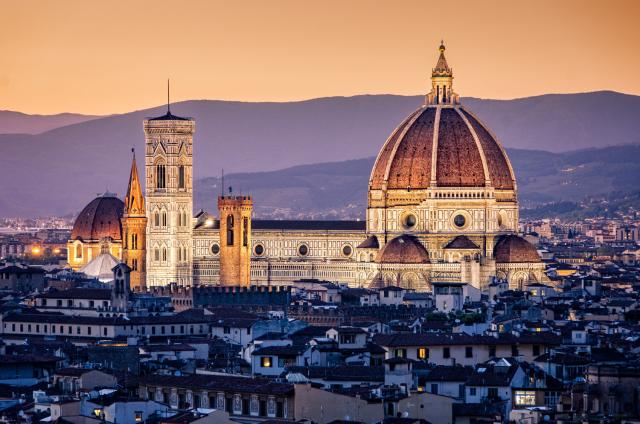 Florence cathedral in Italy
Florence cathedral in Italy
Another option is to find an elevated position to shoot from. This is especially effective when a cathedral dominates the skyline, such as Il Duomo in Florence, Italy. When you're lucky, however, a temple is completely isolated like the Punakha Dzong in Bhutan.
 Punakha Dzong, Bhutan
Punakha Dzong, Bhutan
Also consider the time of day for shooting exteriors. These buildings are usually illuminated in the evening, so the blue hour is a good choice for outdoor shots. And if you're lucky enough to live near your chosen church, consider shooting in different seasons. A fresh snowfall, autumn colors or a stormy sky will give your photos a very different feel.
Increase the ISO setting indoors
Interiors of churches and cathedrals are usually dimly lit and generally do not allow for tripods or flash photography. To compensate for low light, you'll need to raise the ISO. Higher ISOs mean digital noise, so some work will be required in post-production. Modern tools like Lightroom, ON1, Noiseless and so on can handle noise reduction very well.
Pro Tip : Be aware of the photography rules. Respect them. You can get great photos and stay within the guidelines.
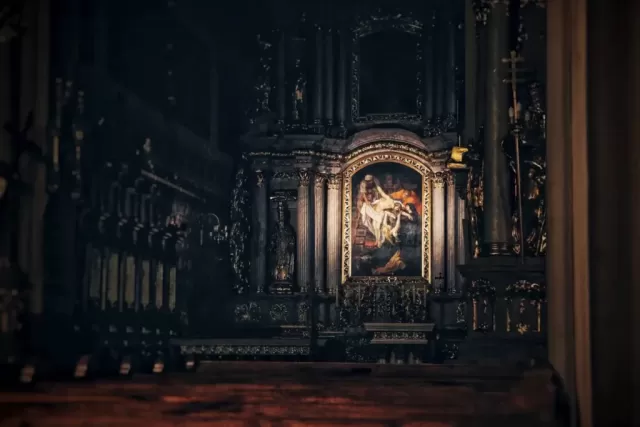
It really helps to know how stable your handheld shooting is. Most people can shoot handheld with a shutter speed of 1/60th of a second with no noticeable camera shake. I happen to be below average sometimes and a shutter speed of 1/80 sec is best for me. Here's the best way to shoot inside a cathedral:
-
Set the camera to Manual mode
-
Set your shutter speed to a speed you're confident you can shoot handheld without camera shake. For me it's that 1/80th sec.
-
Set aperture for desired depth of field. When I'm shooting larger sections of the church, I'm at f/8 or f/11. When I'm shooting detail, I'm usually at f/4.
-
Set the ISO to Auto ISO
Auto-ISO will dynamically choose an ISO sensitivity and give you a good exposure for the shutter speed and aperture you set.
Snap a few photos, check the LCD, and make any changes you need. If your camera doesn't have an Auto-ISO option, start at ISO 800 and work up from there. Depending on your location and what you're including in the shot, your ISO ranges will vary. Going to ISO 6400 or higher is not absurd.
Snap scale and symmetry
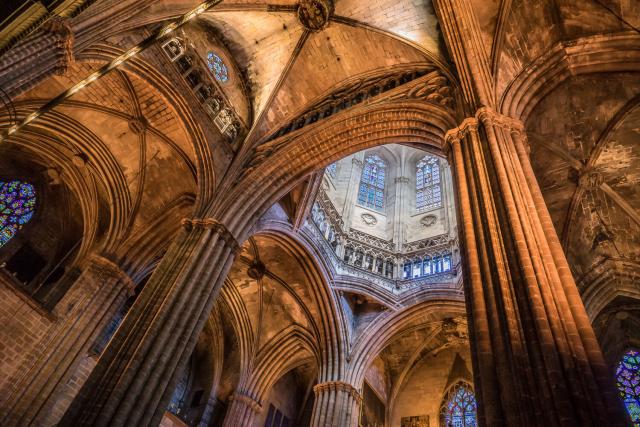 Cathedral of Barcelona, Spain
Cathedral of Barcelona, Spain
The cathedrals and churches are large. Columns, arches and buttresses make us pale. Compose and stamp it on your shots. One of my favorite techniques is shooting from below towards the ceiling, so you have columns rising from the lower corners of the frame. Diagonals give a sense of movement to the photo, drawing the eye upwards. Another technique consists in including a visitor or a praying faithful in the frame.
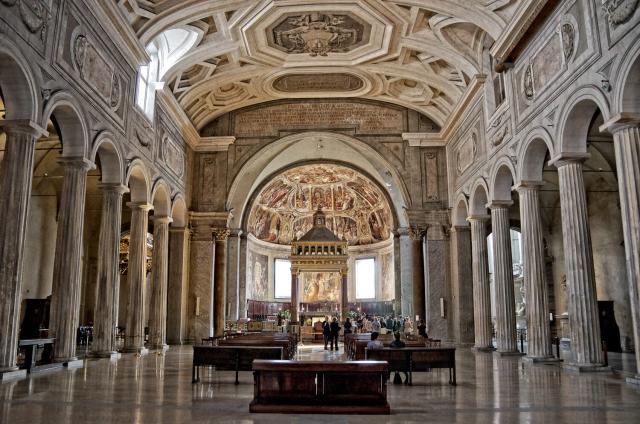 San Pietro in Vincoli, Rome, Italy
San Pietro in Vincoli, Rome, Italy
Churches are also typically symmetrical. Symmetry is a powerful compositional style and churches lend themselves to it. Find the center point of the altar or stand at one end of the church and shoot the entire length of the building. See too. Ceilings have their own forms of symmetry.
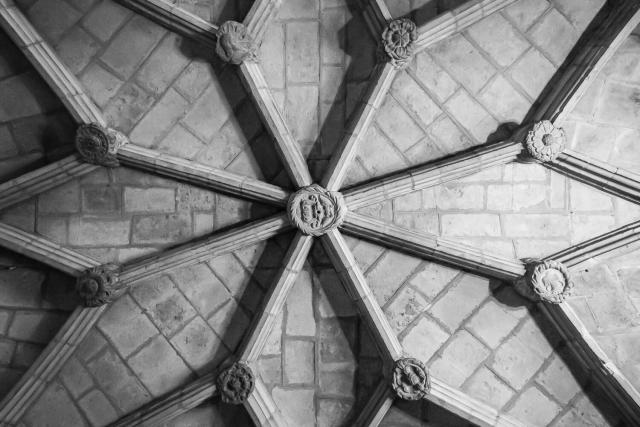 Jerome Monastery, Lisbon, Portugal
Jerome Monastery, Lisbon, Portugal
Pro Tip : Here's a fun exercise. On your next visit to a church, see how many compositional techniques you can use to photograph the interior? You used diagonals and symmetry. And the framing? The reflection?
Snap the details
Churches are full of details. Stone carvings, stained glass windows, decorations, ornaments… the list goes on and on. We are often initially overwhelmed by the size and scale of a cathedral. And I think it's natural. After the overall view, move on to the furnishings: the pews, the altar, the baptismal font, the way of the cross, statues, paintings and tapestries and all the other typical objects of a "church" are obvious subjects to photograph.
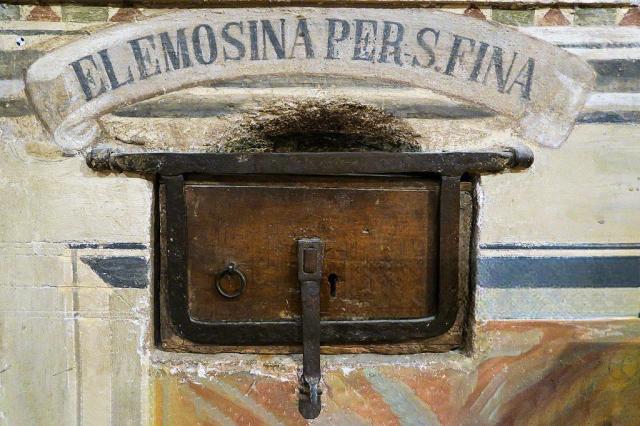 offering box for Santa Fina
offering box for Santa Fina
Ceilings can be richly detailed or painted. Observe the structure looking for elements that you can use as frames starting with the arches. Look for features that serve as guidelines, for example rows of pews force the eye to follow their straight path. Try placing a focus point at the end of them. An altar with candles and a holy book are compositions made just for you!
 Sagrada Familia, Barcelona, Spain
Sagrada Familia, Barcelona, Spain
It's time to take a closer look at everything around you. You'll soon discover all sorts of details on the columns, walls, and even the floor. Get closer, look for the engravings, friezes, writings and photograph only a small segment of the whole.
Detail shots will complement the wider shots as you assemble your photos to tell the story of the cathedral to your friends.
 Sacre Coeur, Paris, France
Sacre Coeur, Paris, France
Find an interesting light
Cathedrals and churches are a great place to snap mid-morning and mid-afternoon. Many cathedrals have large windows that let in sunlight. Pick one and work close to it.
The rays that penetrate the window can be used to guide the eye to a specific feature. You'll have to be patient and wait for the ray of light to get right where you want it to, but sometimes waiting for those few extra minutes can make all the difference. In any case, know that the illuminated dot may change and look different from hour to hour.

One thing is certain, the light will be softer if filtered through glass. Don't forget also that many windows have colored glass and the light will bring a rainbow of colors inside. The stained glass windows can illuminate the floor below with their colors, breaking up the gray concrete with a beautiful kaleidoscope of shades.
 Sagrada Familia, Barcelona Spain
Sagrada Familia, Barcelona Spain
Cathedrals and churches are a great place to photograph in the middle of the day when the sunlight is perpendicular to the ground and photos taken outdoors come out flat and full of harsh shadows.
If you want to photograph the colorful mosaic of the window, start with these parameters: 1/4″ shutter speed, f/4 aperture, ISO200 sensitivity and vary from there. With this slow shutter speed you will need a prop to get the best result, something that acts as a tripod like a pillar, bench, balustrade, bench, on the ground, etc.

The chiaroscuro
When taking panoramic photos inside a cathedral, you may have some dark corners and brightly lit areas.
Your camera's automatics don't know how to handle this situation. To solve the problem, you could use the "bracketing" function and combine the three images with different exposures in post-production. When using this technique, remember to hold the camera as still as possible.

The equipment you need for quality shots in a church or cathedral
Stabilization
If allowed, a sturdy tripod is helpful. If not, and it happens often, you need a camera or lens with an image stabilizer. Both my Nikon camera and my Nikkor lenses have stabilizers and can be successfully handheld at shutter speeds unthinkable a few years ago.
Target selection
Above-mid-range zoom lens for general purpose work or specialist lenses such as extreme wide angle for spectacular perspectives or powerful telephoto for ceilings when using a tripod. Large aperture prime lenses are ideal for handheld shooting.
Software
Adobe Lightroom or Photoshop for image adjustments, but any software that at least allows you to make edits to the Raw files will do, such as ON1 or Noiseless
10 simple tips for better church shots
- For the handgrip, make sure that the camera's image stabilizer and/or lens are turned on. Turn it off when using the tripod.
- Save as raw for more flexibility in post-production.
- Select aperture priority and set the aperture to the widest available. In Program mode, the camera should automatically set the widest aperture based on the intensity of the light.
- Due to mixed lighting (daylight, fluorescent, spotlight), it is safest to set the white balance to Auto and adjust it in post-production. Although this doesn't work so easily when saving in JPEG, so as mentioned, remember to save in raw
- Manually focus about a third of the composition for the hyperfocal distance. It doesn't matter if there's nothing to focus on, just use the lens' focus scale if it has one. In its absence, adjust the focus with guesswork (and experience) back a bit from infinity to about 50 feet.
- Keep the ISO as low as possible for better photo quality. Raise the ISO only when necessary.
- Do not use accessory optics, such as filters or teleconverters, which will reduce the amount of light reaching
the sensor. - E highlighting spot-meter or average tone. Option: Underexpose by -0.3 EV, as overexposed highlights are more difficult to correct in post-production. Keep an eye on the shutter speed in the viewfinder. You can shoot handheld with shutter speeds down to ¼ second, maybe longer. It's not that critical when you're using a tripod.
- Decide on the composition before taking a photo. Position yourself, inhale and hold your breath, press the shutter button in one smooth action without hesitation, exhale.
- Remember to keep an eye out for other people (and photographers) entering the frame.
Post-production in Lightroom
When saving in JPEG, the camera produces an image with adjustments made in-camera that may be difficult to change later. However, when you save in raw, this does not happen. Edits are done in Photoshop with Camera Raw, Lightroom, or a similar application with the added luxury that they can later be undone or edited six months later. This is the workflow in Lightroom. There is no hard and fast rule, every image is different. The best arbiter for making the right decision is your eyes.
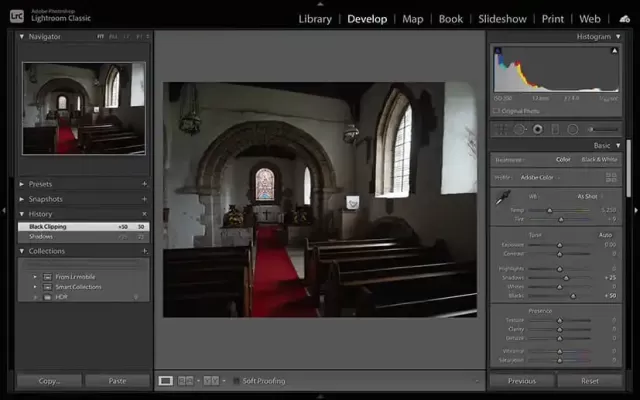 Increase shadow detail
Increase shadow detail
Increase shadow detail
For this example, I opened my image in Adobe Lightroom to make some basic exposure adjustments. I've increased the Shadows and Blacks to bring out more detail. If you raise these settings too much, you'll start introducing noise.
 Color enhancement
Color enhancement
Enhance color
Next I reduced the Highlights and Whites to restore color to the stained glass. To add some punch and saturation, I increased the Exposure, Contrast, Clarity and Vibrance sliders. It's easy to go overboard, so keep checking the original. Always remember that less is more.
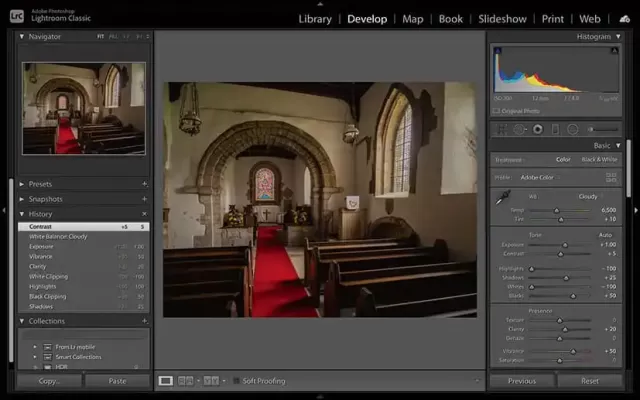 White balance
White balance
White balance
To adjust white balance, I usually start by looking at what the white balance presets have to offer, and if they don't look quite right, I adjust the Temperature and Tint sliders.
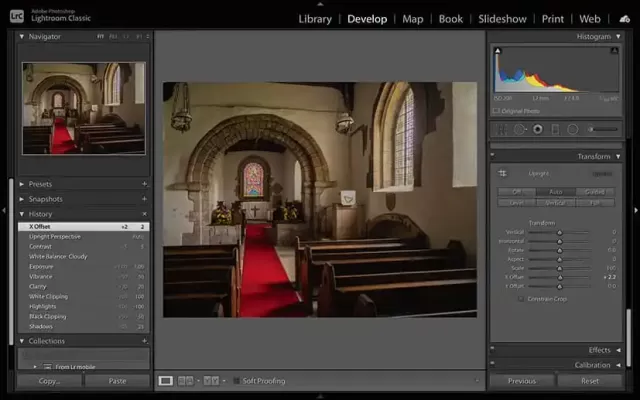 Correct perspective
Correct perspective
Prospect
To fix perspective, try the preset options first. Later, for more control, use the sliders to make finer adjustments. Finally, transfer to Photoshop for adjustments that can't be done in Lightroom.
Conclusions
As you read, the photo opportunities are plentiful. What you need to do now is go out and put the suggested advice into practice.
Test yourself starting with the neighborhood church, the one near your home. Once you get the hang of it and sort out your difficulties, you'll be ready for the biggest and most challenging cathedral you'll ever visit.
When you subscribe to the blog, we will send you an e-mail when there are new updates on the site so you wouldn't miss them.
By accepting you will be accessing a service provided by a third-party external to https://www.insightadv.it/


































































Comments